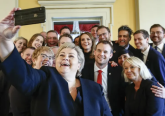 In the wake of the Scottish referendum, the idea of a constitutional convention is gaining popularity. It appeals to the public and the Conservatives are now the only major party resisting a convention in principle. However, as has been discussed on the UCL Constitution Unit blog, the process of realising a convention that can deliver subsequent reform is likely to be fraught with difficulties. If Labour, the Liberal Democrats, the Greens or the SNP were pushed to define the nature and purpose of a UK constitutional convention, it is almost certain that any consensus would fall apart very quickly.
In the wake of the Scottish referendum, the idea of a constitutional convention is gaining popularity. It appeals to the public and the Conservatives are now the only major party resisting a convention in principle. However, as has been discussed on the UCL Constitution Unit blog, the process of realising a convention that can deliver subsequent reform is likely to be fraught with difficulties. If Labour, the Liberal Democrats, the Greens or the SNP were pushed to define the nature and purpose of a UK constitutional convention, it is almost certain that any consensus would fall apart very quickly.
At a recent Constitution Unit seminar, Dr Alan Renwick, Reader in Politics at Reading University and author of After the Referendum: Options for a Constitutional Convention, and Katie Ghose, Chief Executive of the Electoral Reform Society, explored in detail the scope and potential of a UK convention.
Renwick opened with the theoretical perspective, urging the audience to consider what would be desirable in a UK convention, and how options should be judged. More specifically, he offered five criteria to assess effectiveness:
- It should promote reasoning over the interests or passions of particular groups
- The quality of the reasoning is also important. The design of the convention should offer participants the time and support to fully understand the questions under discussion, as well as the implications of suggested solutions.
- The process should aim to include all sections of the population
- It should have public legitimacy, producing outcomes which can be taken seriously
- It should also have political legitimacy so politicians feel an obligation to respect and follow up on outcomes.
Four previous examples of constitutional conventions/citizens’ assemblies were then evaluated against these criteria as options the UK could draw upon in the process of designing its own: Scotland (late 1980s), Iceland (2011), Canada (British Columbia 2004 and Ontario 2006) and Ireland (2012-14).
The Scottish and Icelandic models were quickly rejected. Renwick perceived Scotland’s civil society convention to be flawed because parts of society (often the more disadvantaged sections) are not organised and therefore likely to be underrepresented. Furthermore, in the 25 years since the Scottish convention was founded, democratic expectations have moved on, as has people’s engagement with organised civil society. In contrast, the Icelandic model of a directly elected assembly of non-politicians simply would not translate into the British context. According to Renwick, it was a model that ‘worked fine in most ways in Iceland in 2011’. His point was that Iceland’s population of just 300,000 makes the option of ‘an election without politicians’ viable. The UK’s population is over 200 times larger, so a non-partisan election would be virtually impossible.
The two Canadian citizens’ assemblies and Irish constitutional convention were considered more seriously as options for the UK. The Canadian models met four out of five of Renwick’s criteria: citizen participants were given high levels of support to help them understand and engage with issues presented, thereby ensuring high quality reasoning. Citizens were randomly selected which ensured a high degree of representativeness as well as equal numbers of men and women, and the evidence suggests the process had high public legitimacy. The main problem was politicians were excluded to ensure their interests did not influence proceedings. This negatively impacted political legitimacy because politicians felt no compulsion to take the recommendations of citizens’ assemblies seriously. Although referendums were held, politicians made no attempt to support the proposals and therefore successfully scuppered them.
The Irish constitutional convention sought to improve on the Canadian model by incorporating a minority of politicians who would then act as political ambassadors for the conclusions. In the Irish case, Renwick argued the weaknesses were in the details: for example, the restrictive timetable and the operating style.
Katie Ghose started her presentation by emphasising the desirability of a convention in the wider context of deliberative democracy. She cited citizens’ juries and NHS Citizen as existing examples of deliberative democracy which prove there is both the desire and ability to deliberate technical issues among British citizens.
She then moved on to the question of ‘why a constitutional convention?’ but argued that, given the lack of trust in politicians, the question should really be ‘why should the now-unavoidable constitutional changes be left to politicians?’ In the case of the UK, the ‘why’ is obvious. The ‘who’, however, is more problematic: who is it that should be deliberating? Are there questions that needed to be deliberated by English citizens alone? Perhaps England could benefit from the ‘catch-up time’ to grapple with the constitutional issues that Scots have been debating ‘on hen-nights, in pubs…at the local shop’ for more than two years now. Ghose suggested this might be an argument for phasing, with national conversations conducted before a centralised convention dealing with UK-wide issues, such as the House of Lords.
The agenda would be another potential minefield. Both speakers favoured a narrower focus on the governance of England and the West Lothian question. Renwick argued that any attempt to set up a whole codified constitution would ‘in all likelihood get nowhere in the end’. Ghose indicated there would be ‘a bit of a danger of a kitchen sink to put everything in one convention’, although she did also emphasise that there should be scope for participants to shape the agenda.
Ghose used the discussion of challenges specific to a UK-convention to emphasise the need for pilot constitutional discussions to shape the main event, citing the ‘We the Citizens’ campaign in Ireland as an example. She argued these could be used to establish an appropriate timetable and test agendas. If multiple pilots were held, different sets of questions could be tested. Furthermore, these trial runs would give a sense of the appetite of local politicians and the local media to get involved.
Both presentations acknowledged the complexities of establishing a constitutional convention but they also gave cause for optimism. The speakers demonstrated that even though the multinational nature of the UK presents unique challenges there are national and international precursors that designers of a convention could draw on. The only thing missing is a decisive course of action. As Katie Ghose pointed out, the ideal would be to start formal convention processes now, but realistically this is unlikely to happen before the General Election. The challenge is therefore to maintain the momentum, whether by getting manifesto commitments from parties or exploring options for pilots to include citizen voices in the process of constitutional reform.
Watch the full presentations on our Vimeo page here and here.
This post originally appeared on the blog of the Constitution Unit, which is based in the Department of Political Science at University College London.







No Comment